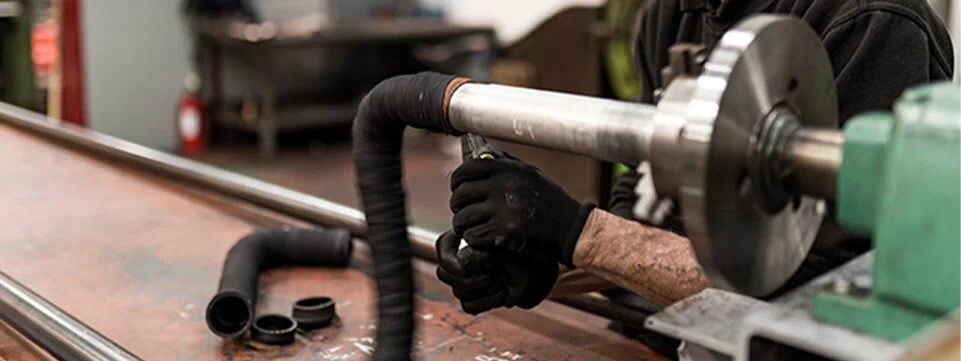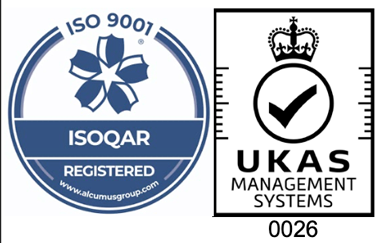Rubber Hoses & Tubing
Rubber hoses and tubing are an ideal choice for transporting edible and non-edible liquids and either dry or waterborne abrasive media.

Rubber hoses and tubing can be made from a range of materials, including silicone rubber tubing, and they are products used in both household and industrial applications. Commonly used outdoors or in a food-grade environment, rubber hoses and tubing from Aquaseal Rubber are manufactured with features or specifications unique to a customer’s application.
Our speciality is hand-built hoses, and our products come with reliable quality, a long lifespan and cost-effectiveness. We can support you in selecting the right material for your bespoke rubber hoses, with a range of materials available, including neoprene and silicone rubber tubing.
What are rubber hoses and tubing used for?
Rubber hoses and tubing are used primarily to transport liquids, gases and abrasive materials in a vast range of industries because of their unique properties. Made from the appropriate materials, ranging from natural rubber to synthetic rubber, like silicone rubber tubing, rubber hoses are flexible, durable and resistant to heat, weather conditions and chemicals.
Typically used to transfer liquids, including water, steam and oil, as well as food-grade products, chemicals, dry powders and abrasive media like sand or cement, rubber hoses and tubing are crucial applications in a range of industries, from manufacturing and construction to the food and beverage, medical and automotive industries.
In specialist hoses for the food or medical industry, food grade rubber is used to ensure the safe transport of liquids, preventing contamination and complying with strict FDA guidelines. In industries like automotive, aerospace and marine, rubber hoses and tubing are used to transport fluids, including coolant, oil, brake fluid and fuel, and must be able to withstand high pressure and extreme environments.
What are Aquaseal’s hoses and rubber tubing suitable for?
With several different types of synthetic rubber available, and since choosing the right rubber material for your hose and tubing needs is essential, it is important that you consult a rubber manufacturing expert like Aquaseal.
We are proud to provide a range of rubber hoses and tubing, including EPDM, neoprene and silicone rubber tubing, to meet varying industry needs. Our rubber hoses and tubing is highly suitable for:
- fuels (oils and diesel)
- water (sea, drill, and fresh)
- mud pump
- chemicals
- dry powders
- sand
- animal feed
- grain
- flour
- cement
- gravel
- construction equipment
- diesel generators
- road sweeper equipment
- hoses for bulk delivery vehicles
- railway brake hoses
- tar spray hoses
- rubber covering of metallic assemblies
What materials do we use for rubber hoses and tubing?
Rubber hoses and tubing are made from either natural or synthetic rubber because they are flexible material options which have good elastic memory and can withstand exposure to heat and chemicals. Since rubber hoses and tubing can be used to transport oils, fuels and chemicals, ensuring your material of choice is suited to these applications is critical to maximise performance and ensure a safe working environment.
Our rubber hoses and tubing are made with reinforcing materials like textile materials or by incorporating wire or nylon helices hose constructions. At Aquaseal Rubber, we manufacture our hoses and tubing from several rubber products, including EPDM, food-grade rubber, and neoprene rubber.
Ethylene Propylene Diene Monomer (EPDM) is used for outdoor applications such as steam hoses because it is resistant to high temperatures and extreme weather conditions, whilst neoprene is used in industrial applications due to its oil and ammonia resistance and is a cost-effective alternative to natural rubber.
Food-grade rubber consists of using silicone, natural rubber, nitrile and neoprene for transporting liquids and pharmaceutical manufacturing. A specially certified grade of rubber approved for use in food manufacturing and packaging, food-grade rubber is non-toxic, non-allergenic, and resistant to mould and water, meaning it is ideal for the safe preparation and storage of food.
One of our most popular products is silicone rubber tubing, which is most commonly used as electrical sleeving because of its insulating properties. However, silicone rubber tubing also has a range of other advantages.
Benefits of silicone rubber tubing
Silicone rubber tubing is a flexible option for rubber hoses and tubing, made from an elastomer known for its several beneficial properties. Manufactured through an extrusion process, a type of synthetic rubber production process, silicone rubber is forced through a die to create the desired tubular shape. Different grades of silicone, such as platinum-cured or peroxide-cured – both with different properties – can be used to manufacture silicone rubber tubing.
Benefits of silicone rubber tubing include:
- High temperature resistance: silicone rubber tubing maintains flexibility and performance in high and low temperature environments
- Flexibility: silicone rubber tubing remains flexible over its wide temperature range and even in high-temperature conditions, is resistant to cracking and becoming brittle
- Chemical resistance: silicone rubber tubing must be resistant to chemicals and non-toxic for its safe usage in medical and food-grade applications, but also when transporting liquid chemicals
- Bacterial resistance: silicone rubber tubing naturally inhibits the growth of bacteria and fungi because it is manufactured from platinum-cured grade silicone, meaning it promotes hygiene in sterile environments
- Durability: silicone rubber tubing is a strong and durable option for your application because of its inherent tear strength
Due to its benefits, silicone rubber tubing has multiple common applications, including medical and pharmaceutical, food and beverage, industrial, scientific and aerospace, automotive and renewable energy systems.
Choosing Aquaseal Rubber for rubber hoses and tubing
Rubber hoses and tubing are crucial applications for a range of industries, and we understand the importance of maintaining and expanding the lifespan of your rubber hoses by selecting the most suitable material for your bespoke application.
You can find out more about the rubber we use or the rubber tubing manufacturing process in our essential guide to rubber tubing.
At Aquaseal Rubber, we work with clients all over the world to ensure we meet their bespoke requirements for rubber hose and tubing applications, including through our silicone rubber tubing. To find out more about how we can support you, contact us today.



